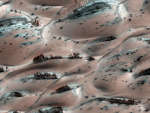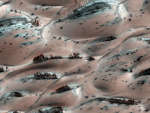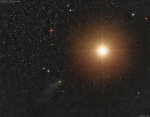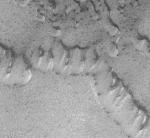
|
You entered: Martian Spring
 Dark Sand Cascades on Mars
Dark Sand Cascades on Mars
25.11.2012
They might look like trees on Mars, but they're not. Groups of dark brown streaks have been photographed by the Mars Reconnaissance Orbiter on melting pinkish sand dunes covered with light frost. The above image was taken in 2008 April near the North Pole of Mars.
 Dark Sand Cascades on Mars
Dark Sand Cascades on Mars
29.11.2015
They might look like trees on Mars, but they're not. Groups of dark brown streaks have been photographed by the Mars Reconnaissance Orbiter on melting pinkish sand dunes covered with light frost. The above image was taken in 2008 April near the North Pole of Mars.
 Dark Sand Cascades on Mars
Dark Sand Cascades on Mars
19.01.2010
They might look like trees on Mars, but they're not. Groups of dark brown streaks have been photographed by the Mars Reconnaissance Orbiter on melting pinkish sand dunes covered with light frost. The above image was taken in 2008 April near the North Pole of Mars.
 APOD: 2025 June 29 Б Dark Sand Cascades on Mars
APOD: 2025 June 29 Б Dark Sand Cascades on Mars
29.06.2025
Are these trees growing on Mars? No. Groups of dark brown streaks have been photographed by the Mars Reconnaissance Orbiter on melting pinkish sand dunes covered with light frost. The featured image was taken in 2008 April near the North Pole of Mars.
 3-D Mars North Pole
3-D Mars North Pole
16.12.1998
This dramatic premier three-dimensional visualization of Mars' north pole is based on elevation measurements made by an orbiting laser. During the Spring and Summer of 1998 the Mars Orbiter Laser Altimeter (MOLA) flashed laser pulses toward the Martian surface from the Global Surveyor spacecraft and recorded the time it took to detect the reflection.
 Light Deposits Indicate Water Flowing on Mars
Light Deposits Indicate Water Flowing on Mars
12.12.2006
What's creating light-toned deposits on Mars? Quite possibly -- water! Images of the same parts of mid-latitude Mars taken over the years but released only last week have shown unexpected new light-toned deposits where there were none before.
 Mars Polar Lander Target Ellipse
Mars Polar Lander Target Ellipse
4.12.1999
South is up in this recent composite color picture of Mars Polar Lander's target region near the Martian South Pole taken on November 28. Imaged by the orbiting Mars Global Surveyor's wide angle camera, the area covered is 105 kilometers across with the expected landing ellipse superposed.
 Mars Opposition
Mars Opposition
27.07.2018
Look opposite the Sun in the sky tonight and you'll see Mars at its brightest. Also within days of its closest approach Mars rises at sunset, near its brightest and best for telescopic observers too, except for the dust storm still blanketing the Red Planet.
 Comet Siding Spring Passes Mars
Comet Siding Spring Passes Mars
20.10.2014
Yesterday, a comet passed very close to Mars. In fact, Comet C/2013 A1 (Siding Spring) passed closer to the red planet than any comet has ever passed to Earth in recorded history. To take...
 The Dunes Of Mars
The Dunes Of Mars
14.08.1998
The North Pole of Mars is ringed by a "sea of sand dunes". For Mars' Northern Hemisphere, Spring began in mid July and increased sunlight is now shrinking the polar cap revealing the wind-swept dunes to the cameras onboard the Mars Global Surveyor spacecraft.
|
January February March April May June July |
|||||||||||||||||||||||||||||||||||||||||||||||||